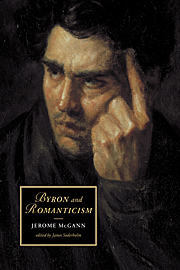Book contents
- Frontmatter
- Contents
- Acknowledgments
- General analytical and historical introduction
- PART I
- 1 Milton and Byron
- 2 Byron, mobility, and the poetics of historical ventriloquism
- 3 “My brain is feminine”: Byron and the poetry of deception
- 4 What difference do the circumstances of publication make to the interpretation of a literary work?
- 5 Byron and the anonymous lyric
- 6 Private poetry, public deception
- 7 Hero with a thousand faces: the rhetoric of Byronism
- 8 Byron and the lyric of sensibility
- 9 Byron and Wordsworth
- PART II
- Subject index
- Authors index
- CAMBRIDGE STUDIES IN ROMANTICISM
6 - Private poetry, public deception
Published online by Cambridge University Press: 22 September 2009
- Frontmatter
- Contents
- Acknowledgments
- General analytical and historical introduction
- PART I
- 1 Milton and Byron
- 2 Byron, mobility, and the poetics of historical ventriloquism
- 3 “My brain is feminine”: Byron and the poetry of deception
- 4 What difference do the circumstances of publication make to the interpretation of a literary work?
- 5 Byron and the anonymous lyric
- 6 Private poetry, public deception
- 7 Hero with a thousand faces: the rhetoric of Byronism
- 8 Byron and the lyric of sensibility
- 9 Byron and Wordsworth
- PART II
- Subject index
- Authors index
- CAMBRIDGE STUDIES IN ROMANTICISM
Summary
[P]oetic reference is not only a question of “the world in the work” but “the work in the world”
– Barrett Watten, Total SyntaxWhen readers today, especially academic readers, think of “the politics of poetic form” in connection with Romanticism, the names that usually come to mind are Blake and Shelley (for the opposition), or Wordsworth and Southey (for the establishment). In the context of 1790–1830, however, and throughout the Euro-American world of the nineteenth and much of the twentieth century, the name that would have been first on everyone's lips was Byron. A political activist in England where he spoke in parliament against capital punishment, later a social pariah who left England for Italy and Greece where he was deeply involved in revolutionary political groups, he finally – famously – died on the west coast of Greece, in the guerilla encampment of Greek Suliotes whom he had joined and personally financed to fight against the Turks for the liberation of Greece.
English public opinion, after worshipping at his shrine for almost five years (1812–1816), finally decided he was the single greatest threat to the country's public morals and social order. This judgment of Byron is written for anyone to see in the English public press of the years 1816–1824. It seems astonishing to us today, and yet it is the simplest fact. We are surprised partly because we do not easily imagine any single person having the kind of political significance which Byron evidently did have.
- Type
- Chapter
- Information
- Byron and Romanticism , pp. 113 - 140Publisher: Cambridge University PressPrint publication year: 2002
- 2
- Cited by

